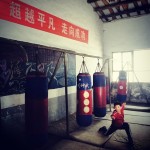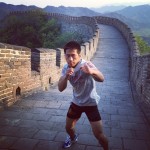I pulled my left butt muscle a couple months ago getting out of bed. It was a sudden rising movement that caused the muscle to seize up, but the problem had been there for some time, dormant and festering, and all it took was a bit of stimulation to bring the issue to the fore. The day before, I had hauled stone around for eight hours, digging up turf and shoveling other things around. Later in the evening I did two classes, Bjj and Muay Thai. Went to a friends house and chilled, was sore, went to bed.
Bam. Next morning I felt pain like I have never felt before. Shooting waves of pain from my left hip down to my toe, through my butt and hamstrings. I knew I had done something to the sciatica nerve, but I was in too much pain to think straight. I took a handful of ibuprofen and in a flash of brilliance called and set up an immediate appointment with an acupuncturist across town. Went in, let Dr. Chen know I speak and understand Chinese and have had acupuncture treatment before, and then stripped and lay down on his bed. He dropped about two dozen needles into me and I felt immediate relief. And I mean immediate. One minute I was struggling to breathe through the pain, the next I was jabbering excitedly about the absence thereof. It was amazing.
Dr. Chen told me the muscles and nerves in my left leg are atrophied and basically refuse to fire correctly. When I strained them, through work and training, I put myself into a position to really hurt myself. The muscles and tendons around the nerve tightened and spasmed, the nerve was pinched, and now the transmission of qi through the nerve to my muscles is not weak like before, but disrupted badly.
I felt numbness in my leg, down to my toes, and I saw my left calf muscle disappear before my very eyes. Now, two months later, I can barely stand on my tip toes with my left foot, and pivoting for a roundhouse kick is physically, and mentally, taxing.
As I went about researching and talking with others about how to rehab, and how difficult it is mentally to deal with an injury that doesn’t really hurt anymore, but nevertheless greatly inhibits my progress, I learned how critical healing is to the martial arts. This is a topic I have written about before: Breaking and Healing in the Martial Arts, but never with as much personal experience.
****
My recent dedication to training as exposed some of my bad habits. Habits I had hoped would melt way with each kick and pound shed, but that hasn’t been the case. As I demand more from my body, so my body demands more from me. I have sat on my ass for many, many, many hours. In front of the computer playing video games, surfing the web, occasionally writing something. I have spent as many hours shying away from stretching and instead praying my “dynamic stretches” would eventually pull and push my stiff muscles into the fluid sacks of potential to kinetic they should be.
So now, at the cusp of 40, I realize how much I have to do to really get in shape. The first thing is of course to understand what is wrong and how to treat it. For me, a sitting lifestyle has led to weak and stiff hips and ass, which in turn lead to stiff and grinding hamstrings and a stiff and sore back. The way to redemption lies in stretching, water, yoga, daily dedication to movement and activation. It doesn’t sound hard, but …. I hate stretching right now. I hate running too, but that’s a post for a different time.
For now, I think it’s a good thing that I realize the balance in martial arts and how important it is to maintain both yin and yang.
***
And as a sidenote, feeling the imbalance in my journey through the martial arts, between healing and training, maintenance and challenge, has opened my eyes to more abstract balances. Between the scholar and the warrior, the poet and the mercenary, the man of culture and the man of action. I was reminded of this not only through my physical struggles, but also through the writings of Xenophon, a Greek soldier and historian who fought in Persia many centuries ago. His writings, in turn, led me to many other poets of that era, who sat by the campfire and composed lines after a long march, before another day on the march or, better yet, a meeting in the field.






